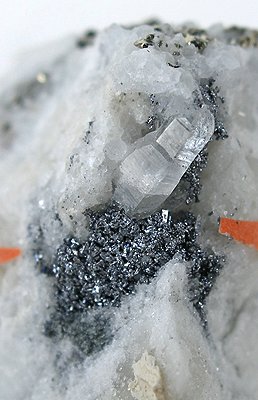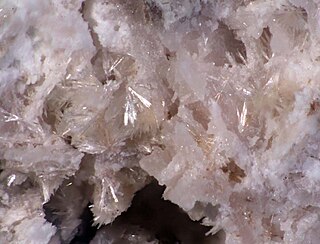Related Research Articles

Mineralogy is a subject of geology specializing in the scientific study of the chemistry, crystal structure, and physical properties of minerals and mineralized artifacts. Specific studies within mineralogy include the processes of mineral origin and formation, classification of minerals, their geographical distribution, as well as their utilization.

Alstonite, also known as bromlite, is a low temperature hydrothermal mineral that is a rare double carbonate of calcium and barium with the formula BaCa(CO
3)
2, sometimes with some strontium. Barytocalcite and paralstonite have the same formula but different structures, so these three minerals are said to be trimorphous. Alstonite is triclinic but barytocalcite is monoclinic and paralstonite is trigonal. The species was named Bromlite by Thomas Thomson in 1837 after the Bromley-Hill mine, and alstonite by August Breithaupt of the Freiberg Mining Academy in 1841, after Alston, Cumbria, the base of operations of the mineral dealer from whom the first samples were obtained by Thomson in 1834. Both of these names have been in common use.

Vauxite is a phosphate mineral with the chemical formula Fe2+Al2(PO4)2(OH)2·6(H2O). It belongs to the laueite – paravauxite group, paravauxite subgroup, although Mindat puts it as a member of the vantasselite Al4(PO4)3(OH)3·9H2O group. There is no similarity in structure between vauxite and paravauxite Fe2+Al2(PO4)2(OH)2·8H2O or metavauxite Fe3+Al2(PO4)2(OH)2·8H2O, even though they are closely similar chemically, and all minerals occur together as secondary minerals. Vauxite was named in 1922 for George Vaux Junior (1863–1927), an American attorney and mineral collector.
Mosesite is a very rare mineral found in few locations. It is a mercury mineral found as an accessory in deposits of mercury, often in conjunction with limestone. It is known to be found in the U.S. states of Texas and Nevada, and the Mexican states of Guerrero and Querétaro. It was named after Professor Alfred J. Moses (1859–1920) for his contributions to the field of mineralogy in discovering several minerals found alongside mosesite. The mineral itself is various shades of yellow and a high occurrence of spinel twinning. It becomes isotropic when heated to 186 °C (367 °F).

Marrite (mar'-ite) is a mineral with the chemical formula PbAgAsS3. It is the arsenic equivalent of freieslebenite (PbAgSbS3), but also displays close polyhedral characteristics with sicherite and diaphorite. Marrite was named in honor of geologist John Edward Marr (1857–1933) of Cambridge, England.

Wakabayashilite is a rare arsenic, antimony sulfide mineral with formula [(As,Sb)6S9][As4S5].
Jonesite is a mineral with the chemical formula Ba4(K,Na)2[Ti4Al2Si10O36]*6H2O. This mineral is named after Francis Tucker Jones (1905–1993), who discovered the mineral while working as a Research Chemical Microscopist at Berkeley in CA. Jonesite has diffraction symmetry of mmm, which implies an orthorhombic system with all three axes perpendicular to each other and the angles between each axis equal to 90 degrees. In addition to symmetrical properties, Jonesite is a biaxial mineral with birefringence, which is a term to describe the difference between index of refraction. Jonesite is anisotropic, meaning the speed of light changes through the mineral, so the mineral shows color when viewed in crossed polarized light under a microscope. The mineral also has medium relief, which is a measure of how well the mineral stands out when viewed under a microscope in plane polarized light. In addition to being one of the rarest minerals in the Benitoite Gem mine located in California, Jonesite also is the first titanosilicate mineral with a porous double-layered crystal structure. This discovery is important because titanosilicate frameworks have industrial uses in energy companies and are used in containing radioactive waste.

Leightonite is a rare sulfate mineral with formula of K2Ca2Cu(SO4)4•2H2O.
Kochite is a rare silicate mineral with chemical formula of (Na,Ca)3Ca2(Mn,Ca)ZrTi[(F,O)4(Si2O7)2] or double that. Kochite is a member of the rosenbuschite group.

Christite is a mineral with the chemical formula TlHgAsS3. It is named after Dr. Charles L. Christ, a member of the U.S. Geological Survey. It usually comes in a crimson red or bright orange color. It has a density of 6.2 and has a rating between 1 and 2 on Mohs Hardness Scale. Christite has an adamantine luster and leaves behind an orange streak. Its crystal system is monoclinic with possible crystal classes of twofold symmetry, mirror plane symmetry, and twofold with a mirror plane. This means it can have radial symmetry, mirror plane symmetry, or mirror plane symmetry perpendicular to the two-fold axis. It is an anisotropic mineral, which means that it exhibits different properties when measured in different directions. In plane polarized light, its color is golden yellow. It is birefringent, which means that it has two distinct indices of refraction. This can be seen when one looks through the microscope with both polars crossed and sees the mineral change colors when it is rotated.
Sacrofanite is a rare silicate mineral that has the general formula of (Na,Ca)9(Si,Al)12O24(SO4,CO3,OH,Cl)4·n(H2O). It was approved as a mineral by the International Mineralogical Association in 1980. Its name comes from the Sacrofano Caldera in the Monti Sabatini from which it was discovered in Latium, Italy.

Quintinite is a carbonate mineral with the chemical formula Mg4Al2(OH)12CO3⋅3H2O.

Devilline is a sulfate mineral with the chemical formula CaCu4(SO4)2(OH)6•3H2O. The name originates from the French chemist's name, Henri Etienne Sainte-Claire Deville (1818–1881).
Loveringite is a rare metallic oxide mineral of the crichtonite group with the chemical formula (Ca,Ce)(Ti,Fe,Cr,Mg)21O38. It is a late-stage magmatic mineral, formed in the residual melt of mafic layered intrusions in either the olivine-chromite, pyroxene, or plagioclase-rich layers.

Stellerite is a rare mineral discovered by and named after Georg Wilhelm Steller, a German explorer and zoologist. The mineral has a general formula of Ca[Al2Si7O18]·7H2O. Like most rare minerals, there are few commercial uses for stellerite. Mineral collectors are lucky to find it in good enough crystal form. Zeolites, including stellerite, have been studied using a dehydration process to gauge the potential use of their phases as molecular sieves, sorbents, and catalysts.

Malayaite is a calcium tin silicate mineral with formula CaSnOSiO4. It is a member of the titanite group.

Laplandite has a general formula of Na4CeTiPO4Si7O18•5H2O, and is found primarily in igneous rocks. This silicate mineral has been found as inclusions in pegmatites, primarily in the Kola Peninsula in Lappland, where the mineral's name gets its origin. Laplandite is orthorhombic, which states that crystallographically, it contains three axes of unequal lengths that all intersect at 90 degrees, perpendicular to one another. The shape of the crystal is bipyramidal, and is similar in structure to olivine or aragonite. Because of these different axes lengths, it shows anisotropism, which will allow for the visibility of birefringence. This property can give the mineral very distinct colors when viewed under cross-polarization. Laplandite has three different indices of refraction, which are measures of the speed of light in vacuum divided by the speed of light within the mineral, determined individually on each axis. Due to these different indices, Laplandite is a biaxial mineral, which states that the mineral will have two optic axes. Under the microscope, this mineral has moderate relief, which describes the contrast between Laplandite's refractive index and the refractive index of the mounting medium on which it is placed. The relief can be seen physically as how easily you can see the boundary lines of the mineral under plane polarized light in a petrographic microscope.

Fluor-uvite is a tourmaline mineral with the chemical formula CaMg3(Al5Mg)(Si6O18)(BO3)3(OH)3F. It is a rare mineral that is found in calcium rich contact metamorphic rocks with increased amounts of boron. Uvite is trigonal hexagonal, which means that it has three equal length axes at 120 degrees, all perpendicular to its fourth axis which has a different length. Uvite is part of the space group 3m. Uvite's hardness has been measured to be 7.5 on the Mohs hardness scale. The color of uvite widely varies, depending on the sample, but is mostly deep green or brown. In regard to uvite's optical properties, it is uniaxial (-) and anisotropic, meaning that the velocity of light in the mineral depends on the path that it takes. In plane polarized light, uvite is colorless to pale yellow and shows weak pleochroism.

Carminite (PbFe3+2(AsO4)2(OH)2) is an anhydrous arsenate mineral containing hydroxyl. It is a rare secondary mineral that is structurally related to palermoite (Li2SrAl4(PO4)4(OH)4). Sewardite (CaFe3+2(AsO4)2(OH)2) is an analogue of carminite, with calcium in sewardite in place of the lead in carminite. Mawbyite is a dimorph (same formula, different structure) of carminite; mawbyite is monoclinic and carminite is orthorhombic. It has a molar mass of 639.87 g. It was discovered in 1850 and named for the characteristic carmine colour.

Edoylerite is a rare mercury containing mineral. Edoylerite was first discovered in 1961 by Edward H. Oyler, whom the mineral is named after, in a meter-sized boulder at the Clear Creek claim in San Benito County, California. The Clear Creek claim is located near the abandoned Clear Creek mercury mine. The material from the boulder underwent several analyses including, X-ray powder diffraction (XRD), a single crystal study, and a preliminary electron microprobe analysis (EMA). Using these analyses it was determined that this was a new mineral but the nature of the material at the time prevented further investigation. It was not until 1986, with the discovery of crystals large enough for a crystal structure determination and a sufficient quantity for a full mineralogical characterization, that the study was renewed. The new edoylerite crystals were found in the same area at the Clear Creek claim but were situated in an outcrop of silica-carbonate rock. This silica-carbonate rock was mineralized by cinnabar following the hydrothermal alteration of the serpentinite in the rock. Edoylerite is a primary alteration product of cinnabar. Though found with cinnabar, the crystals of edoylerite do not typically exceed 0.5mm in length. The ideal chemical formula for edoylerite is Hg32+Cr6+O4S2
References
- ↑ Warr, L.N. (2021). "IMA–CNMNC approved mineral symbols". Mineralogical Magazine. 85 (3): 291–320. Bibcode:2021MinM...85..291W. doi: 10.1180/mgm.2021.43 . S2CID 235729616.
- 1 2 "General Samuelsonite Information" . Retrieved 2 October 2010.
- 1 2 Jolyon Ralph and Ida Chau. "Samuelsonite". mindat.org . Retrieved 2 October 2010.
- ↑ Handbook of Mineralogy
- ↑ "Samuelsonite R080081" . Retrieved 2 October 2010.
- ↑ Rapp Jr. G.R., Campbell, T.J., and Roberts, W.L. (1990) Enclycopedia of Minerals (2nd Edition) 797 p. Library of Congress Cataloging, Washington, D.C.